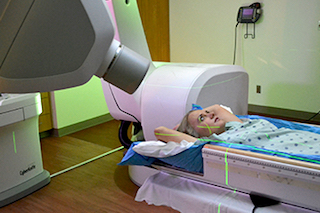
Doctors have been using radiation to fight cancer for about 100 years. The good news for cancer patients: Our aim keeps getting better and better.
Take, for example, SBRT, or stereotactic body radiation therapy. This technology so precisely targets tumors that little, if any, healthy tissue is affected.
The future of radiation therapy lies in treating metastatic cancer, which is cancer that has spread from its point of origin to other parts of the body and which is particularly difficult to treat. Currently, studies and clinical trials are underway to hone the technology we have and to develop new technology to fight these cancers.
These developments offer hope to cancer patients who, in previous eras, often could not receive effective treatment.
As scientists, we’re always looking for answers – through investigation, trial and error, and deep thought. We stand on the shoulders of those who’ve come before us, and the work is now paying off in a big way for our patients.
The evolution of radiation
In the early 1900s, we learned that doses of radiation interfere with the dividing of cells. When cells can’t divide, they cease to multiply. In the case of cancer cells, radiation doses reduce the size of cancerous tumors, sometimes shrinking them away completely.
Though some early radiation treatments were successful, they often came with side effects. Because the radiation beams could not be precisely pointed at a tumor, the overflow damaged the healthy tissue around the tumor. By the 1950s and ’60s, we were able to point the radiation more and more precisely, but there were still some ill effects.
In the late 1960s, neurosurgeons wanted to try using radiation therapy against brain tumors. You can see the problem. If radiation were to damage healthy brain tissue, patients could suffer serious consequences – perhaps losing the ability to speak or walk ever again.
Luckily, during the 1960s great advances were made in medical imaging. CT and MRI technology allowed a much more accurate view into the brain. Using that technology, neurosurgeons were able to point radiation directly at a tumor and avoid affecting nearby healthy tissue. This therapy is called stereotactic radio surgery and is still used today.
Following that lead, oncologists fighting cancer in other areas of the body developed ways to use stereotactic radio surgery. The problem with using the therapy on, say, the lungs is that lungs move. We can keep the head still for brain procedures, but we can’t stop a patient from breathing. In the 1980s, procedures were developed to “dampen” the movement of the body. Coupled with that, even more advanced imaging techniques came along that allowed us to more precisely pinpoint the location of the tumor.
With a still body and a clear location of the cancer, the doors opened to using radiation therapy on all types of tumors, including those of the lungs and prostate.
We have a long way to go to perfect radiation therapy, but we also have come a long way.
Seeking treatment
If you have a cancer diagnosis, we encourage you to seek a second opinion. It’s always a good idea to have different experts weigh in on your condition to see what treatments are best for you. Some treatments might be brand new, or at the clinical trial stage.
At UT Southwestern, we have a cancer team that works in all corners of the hospital, from radiation to surgery to specialized nurses, plus an active research program testing innovative treatments. To get more information about our clinical trials, to understand a diagnosis, or to ask other cancer-related questions, call our Cancer Answer Line at 1-888-980-6050.











